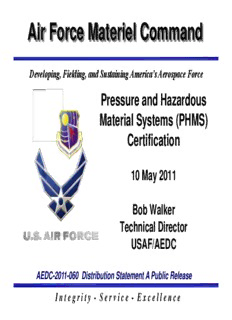
Managing the Pressure Systems Program at Arnold Engineering Development Center PDF
Preview Managing the Pressure Systems Program at Arnold Engineering Development Center
Air Force Materiel Command Developing, Fielding, and Sustaining America’s Aerospace Force Pressure and Hazardous Material Systems (PHMS) Certification 10 May 2011 Bob Walker Technical Director USAF/AEDC AEDC-2011-060 Distribution Statement A Public Release I n t e g r i t y - S e r v i c e - E x c e l l e n c e $11.3 billion replacement value 43 test cells 5-year funding average: $ 368 million NFAC Mountain View, CA • Approximately 2,400 people employed including military, government civilians, and contractor personnel • Approximately 40,000 acres Tunnel 9 encompassing a 4,000 acre White Oak, MD industrial site Outline • Purpose/Significance • The Goal of Certification • Program History at AEDC • What Qualifies as PHMS? • The Certification Process • Current Status • Future Expectations • Summary 3 Purpose/Significance • The purpose of this briefing is to familiarize the conference attendees with PHMS Certification • Significance of certification – Required to perform the mission. – Aging systems, budgets stretched to cover mnx – Systems lack tech data and configuration history. – No in-service inspection – Severe system failures (NASA, DoD and Industry). – Significant potential energy (hazard/severity) – We have demonstrated certification can be performed at a fraction of replacement cost (10%) 4 Intent • Bring aged/unknown configurations up to Code. • Reduce operational risk/lower probability of failure. • New PHMS would be acquired and maintained to Code by other projects. • Once a system is certified, it would be maintained in a certified condition- configuration. 5 The Goal of Certification 1. Provide the baseline documentation verifying that a pressure system was designed, constructed, inspected, repaired and tested in accordance with applicable codes and standards. 2. Provide a system that is considered safe for operation at AEDC. 3. Create ISI plans and PM procedures a) To maintain certification. b) Monitor for areas of degradation in the future. 6 Program History at AEDC • AEDC program began in 1989 with award of certification contract. – Approximately $3M/year program ($60M/20 yrs). – 150 original systems. – Decisions at initial contract award not to include J6, ASTF, SL, Hydraulics. • AEDC PHMS Systems have a replacement value > $500M (estimate) . 7 Program History at AEDC ETF – B ??? O&M ETF – A Helium - MKI ISI-PMs Fuels APTU HPA PHMS PWT Tunnels GN2 Certification Surplus Vessels New PHMS High Pressure Air ASTF 1950s 1960s 1970s 1980s 1990s 2000s 2010s ???s 8 PHMS by Definition • Non-Category D pressure systems – The design gauge pressure exceeds 150 psi – The design temperature is less than -20 or greater than 366°F – The fluid handled is flammable or toxic • Any additional system that is deemed to be mission critical can be included. • Defined in AEDC Safety and Pressure Design Standards. 9 Exclusions – Plumbing, Sewer Systems, Potable Water Supply Piping. – Non-Industrial Fire Sprinkler Piping. – Electrical Conduit. – Test Articles. – Facility Heating, Ventilating, and Air Conditioning. – Piping of Plastic, Glass, or Any Nonmetallic Material. Note: Defined in AEDC Safety and Pressure Design Standards. 10
Description: